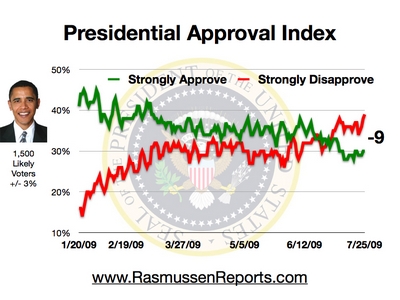While the President’s ratings have slipped over the past month, 54% believe that President George W. Bush is still primarily to blame for the nation’s economic problems. Just 25% believe that the economic stimulus package has helped the economy.
California Senator Barbara Boxer is clinging to a four-point lead in her bid for re-election.
Fifty-three percent (53%) now oppose the Congressional health care reformdeficit reduction is most important. package. That’s up eight points over the past month. Just 20% now see health care as the most important of the President’s priorities. Nearly twice as many, 37%, say
Fifty-five percent (55%) of California voters oppose the budget agreement reached by the state’s political leaders. Sixty-four percent (64%) believe that illegal immigrants create a major strain on the state’s budget.
Nationwide, 72% don’t want the federal government determining what type of light bulbs they should purchase.
Forty-six percent (46%) say that network television news is more reliable than the internet. Thirty-five percent (35%) disagree.
Thirty-one percent (31%) now say the U.S. is heading in the right direction. That’s down nine points from the 2009 peak. Republicans continue to enjoy a slight edge on the Generic Congressional Ballot.
Please take our Daily Prediction Challenge and predict the results of upcoming polls.
If you'd like Scott Rasmussen to speak at your meeting, retreat, or conference, contact Premiere Speakers Bureau. You can also learn about Scott's favorite placehockey legend Gordie Howe. on earth or his time working with
When comparing Job Approval data from different firms, it's important to keep in mind that polls of likely voters and polls of all adults will typically and consistently yield different results. In the case of President Obama, polls by all firms measuring all adults typically show significantly higher approval ratings than polls of likely voters. Polls of registered voters typically fall in the middle. Other factors are also important to consider when comparing Job Approval ratings from different polling firms.
A Fordham University professor has rated the national pollsters on their record in Election 2008. We also have provided a summary of our results for your review.
Daily tracking results are collected via telephone surveys of 500 likely voters per night and reported on a three-day rolling average basis. The margin of sampling error—for the full sample of 1,500 Likely Voters--is +/- 3 percentage points with a 95% level of confidence. Results are also compiled on a full-week basis and crosstabs for full-week results are available for Premium Members.
Like all polling firms, Rasmussen Reports weights its data to reflect the population at large (see methodology). Among other targets, Rasmussen Reports weights data by political party affiliation using a dynamic weighting process. While partisan affiliation is generally quite stable over time, there are a fair number of people who waver between allegiance to a particular party or independent status. Over the past four years, the number of Democrats in the country has increased while the number of Republicans has decreased.
Our baseline targets are established based upon separate survey interviews with a sample of adults nationwide completed during the preceding three months (a total of 45,000 interviews) and targets are updated monthly. Currently, the baseline targets for the adult population are 39.0% Democrats, 32.5% Republicans, and 28.5% unaffiliated. Likely voter samples typically show a slightly smaller advantage for the Democrats.
Now At: religiopoliticaltalk.com
This site is search-able for old posts and I will keep it up for that reason.
